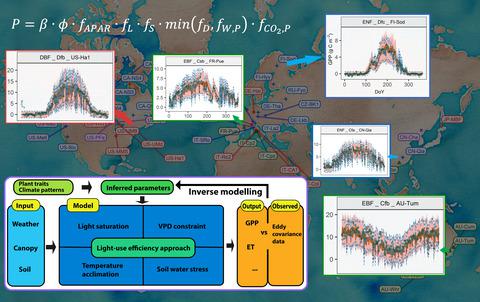当前位置:
X-MOL 学术
›
Glob. Change Biol.
›
论文详情
Our official English website, www.x-mol.net, welcomes your feedback! (Note: you will need to create a separate account there.)
Extending the range of applicability of the semi-empirical ecosystem flux model PRELES for varying forest types and climate.
Global Change Biology ( IF 11.6 ) Pub Date : 2020-03-06 , DOI: 10.1111/gcb.14992 Xianglin Tian 1, 2 , Francesco Minunno 2 , Tianjian Cao 1 , Mikko Peltoniemi 3 , Tuomo Kalliokoski 2, 4 , Annikki Mäkelä 2
Global Change Biology ( IF 11.6 ) Pub Date : 2020-03-06 , DOI: 10.1111/gcb.14992 Xianglin Tian 1, 2 , Francesco Minunno 2 , Tianjian Cao 1 , Mikko Peltoniemi 3 , Tuomo Kalliokoski 2, 4 , Annikki Mäkelä 2
Affiliation

|
Applications of ecosystem flux models on large geographical scales are often limited by model complexity and data availability. Here, we calibrated and evaluated a semi-empirical ecosystem flux model, PRELES, for various forest types and climate conditions, based on eddy covariance data from 55 sites. A Bayesian approach was adopted for model calibration and uncertainty quantification. We applied the site-specific calibrations and multisite calibrations to nine plant functional types (PFTs) to obtain the site-specific and PFT specific parameter vectors for PRELES. A systematically designed cross-validation was implemented to evaluate calibration strategies and the risks in extrapolation. The combination of plant physiological traits and climate patterns generated significant variation in vegetation responses and model parameters across but not within PFTs, implying that applying the model without PFT-specific parameters is risky. But within PFT, the multisite calibrations performed as accurately as the site-specific calibrations in predicting gross primary production (GPP) and evapotranspiration (ET). Moreover, the variations among sites within one PFT could be effectively simulated by simply adjusting the parameter of potential light-use efficiency (LUE), implying significant convergence of simulated vegetation processes within PFT. The hierarchical modelling of PRELES provides a compromise between satellite-driven LUE and physiologically oriented approaches for extrapolating the geographical variation of ecosystem productivity. Although measurement errors of eddy covariance and remotely sensed data propagated a substantial proportion of uncertainty or potential biases, the results illustrated that PRELES could reliably capture daily variations of GPP and ET for contrasting forest types on large geographical scales if PFT-specific parameterizations were applied.
中文翻译:

扩展了半经验生态系统通量模型PRELES在不同森林类型和气候下的适用范围。
生态系统通量模型在较大地理尺度上的应用通常受到模型复杂性和数据可用性的限制。在这里,我们基于55个站点的涡度协方差数据,针对各种森林类型和气候条件,对半经验式生态系统通量模型PRELES进行了校准和评估。采用贝叶斯方法进行模型校准和不确定性量化。我们对9种植物功能类型(PFT)应用了特定于站点的校准和多站点校准,以获得PRELES的特定于站点和PFT的参数向量。进行了系统设计的交叉验证,以评估校准策略和外推风险。植物生理性状和气候模式的结合在PFT范围内而不是PFT范围内产生了植被响应和模型参数的显着变化,这意味着应用没有PFT特定参数的模型是有风险的。但是在PFT中,在预测总初级生产量(GPP)和蒸散量(ET)中,多站点校准的执行效果与特定于站点的校准一样准确。此外,通过简单地调整潜在光利用效率(LUE)的参数,就可以有效地模拟一个PFT中站点之间的变化,这意味着PFT中模拟植被过程的显着收敛。PRELES的分层建模在卫星驱动的LUE和生理学方法之间进行折衷,以推断生态系统生产力的地理变化。
更新日期:2020-04-22
中文翻译:

扩展了半经验生态系统通量模型PRELES在不同森林类型和气候下的适用范围。
生态系统通量模型在较大地理尺度上的应用通常受到模型复杂性和数据可用性的限制。在这里,我们基于55个站点的涡度协方差数据,针对各种森林类型和气候条件,对半经验式生态系统通量模型PRELES进行了校准和评估。采用贝叶斯方法进行模型校准和不确定性量化。我们对9种植物功能类型(PFT)应用了特定于站点的校准和多站点校准,以获得PRELES的特定于站点和PFT的参数向量。进行了系统设计的交叉验证,以评估校准策略和外推风险。植物生理性状和气候模式的结合在PFT范围内而不是PFT范围内产生了植被响应和模型参数的显着变化,这意味着应用没有PFT特定参数的模型是有风险的。但是在PFT中,在预测总初级生产量(GPP)和蒸散量(ET)中,多站点校准的执行效果与特定于站点的校准一样准确。此外,通过简单地调整潜在光利用效率(LUE)的参数,就可以有效地模拟一个PFT中站点之间的变化,这意味着PFT中模拟植被过程的显着收敛。PRELES的分层建模在卫星驱动的LUE和生理学方法之间进行折衷,以推断生态系统生产力的地理变化。



























 京公网安备 11010802027423号
京公网安备 11010802027423号